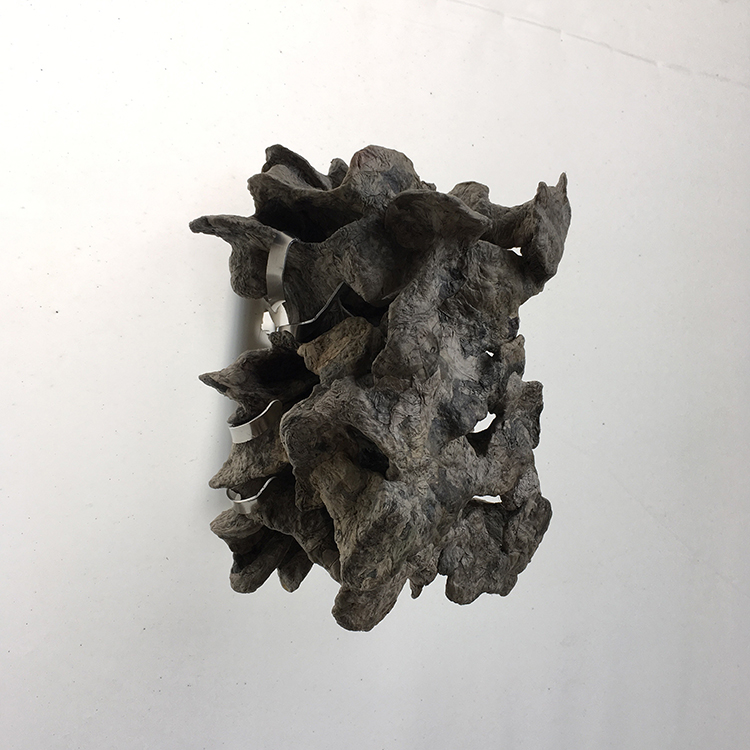
MARIE MAERTENS
( journalist, art critic, independent curator )
_______________________________________________________________
Bill Jenkins
_______________________________________________________________

Panel Number 5, 2017
Paper maché, aluminum clasp, plastic scrim
Bill Jenkins was in residence at the Atelier Calder in Saché, France in the Fall of 2017. I visited him near the end of the residency, where we spoke about his experience there and some of his previous projects.
Can we go back to the beginning, when I met you and you liked to go outside to find the objects for your future works?
Yes, I was on the hunt for objects that appealed to me, always. I would find a lot of things on nighttime walks in my neighborhood in Brooklyn, occasionally I would buy things in stores, mostly I found items at jobs I worked. When I first moved to New York I worked light construction and gardening jobs and I’d usually go home at the end of the day with a fragment of wood or concrete or wire or something. I would pick up anything I could carry that I saw some appeal or potential in. My apartment became very full of these things.
And then how did you decide to turn them into artworks?
I really had to live with things for a long time, to wait and see if my initial interest in the item would grow and evolve, decline, or remain the same. And then with that sense of an object’s more long-term qualities, I could figure out how to present the item as an artwork. I wanted to present the objects with the least amount of augmentation possible, mainly focusing on the orientation of something and if it would be combined with other objects or not.
So sometimes you didn’t change anything?
Well, I think it’s impossible not to change the things I was picking up, that would happen just by picking it up and moving it—changing its physical and user context. But I tried to hold myself to the idea that if my work was taken back out to the street it would blend back in and not seem like it came from a studio or gallery, even if it was something that I had fabricated from scratch. I also liked the idea that my work could be taken apart and each thing would be itself again, how I found it.
I worked with Sam Moyer and Gedi Sibony for the exhibition The Surface of the East Coast, and I noticed that their way of working, in the very beginning, is more or less the same as yours. Did you know these artists before?
Yes, I was aware of their work at the time. While I probably share more of a formal and material approach with Moyer and Sibony, at the time I was thinking about artists like Haim Steinbach and Zoe Leonard….and a Bob Nickas piece about Laurie Parsons was in the back of my mind too. I appreciate that in their collection and presentation practices they manage to allow the found objects they use to maintain some independence within their display schemes rather than absorb the items, turning them into compositional elements. I felt the things that I would find and pick up were interesting in and of themselves and they didn’t need my help other than to present them. I was then and am still more interested in objects themselves than composing with objects.
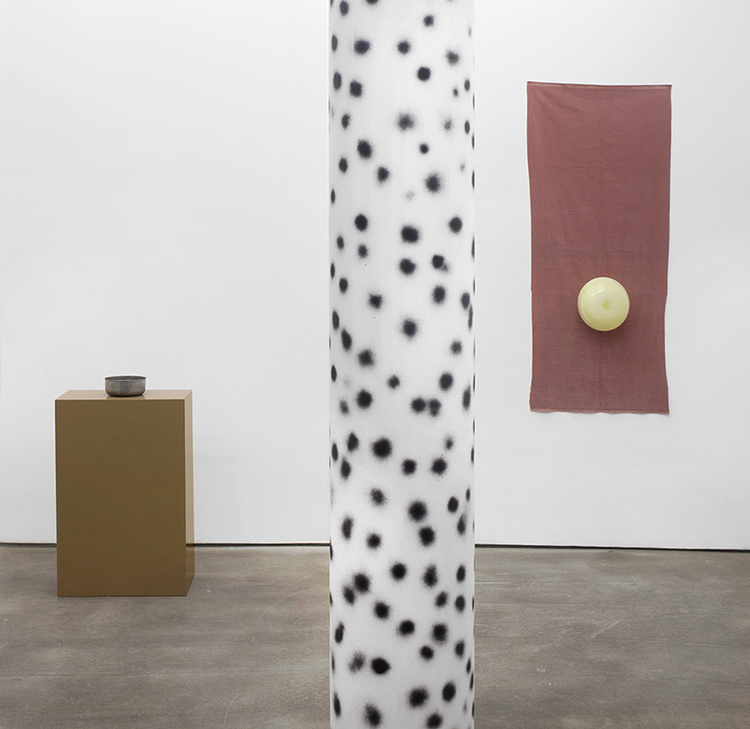
Long Ending , 2012 . solo show at Laurel Gitlen installation view ( Photo: Cathy Carver )
I think the time you spend in your studio and with your pieces is very important in the elaboration of your work.
It takes me a long time to know where I’m going with a piece and then a long time to feel confident in the finished work. After I initially found an object I then had to find its presentation. In most cases I never found the presentational aspect, giving an object a fixed position ultimately diminished it for me. When I did finish a piece in a technical sense it would then take me another week or another month to really decide if I was satisfied with it, if it maintained an effect beyond my initial pleasure in its presentation. It was important to me to live with all of this stuff, to always be around it, to not limit it to a certain kind of relationship where I only deal with it when I’m in a self-conscious studio mode. Ideally, someone else eventually lives with the artworks and so I was interested in what these things were like to live with more than what they would temporarily look like in a white box or online.
And in terms of scale and installation, can we say that your last exhibition with Laurel Gitlen, Wet Light, where you decided to envelope the entire gallery, was a shift?
Yes, it was a really big shift. We’ve been speaking about modestly scaled, slowly made works, and this show was more improvisational, immersively big, and in the end more ephemeral. It was the first time that I worked with the entire space, and the first time I was building structures that moved light around. In past shows I always felt that the placement of art objects within the specific geometry of an exhibition space became, by default, a formal aspect of the artwork. I had done some large wall paintings that were meant to optically destabilize the architecture they were applied to, but this installation was a move to deal with space and light only and entirely.
And it was really a big change for you?
It was a large development, yes. As soon as I had the idea to deal with light and space alone, I was freed up to think and work much more quickly. Instead of thinking about putting objects in certain spaces, I just thought about the spaces themselves and what was available on site. I was thinking a little bit of the large-scale earthworks in the American West at the time. Nancy Holt had just died and I attended a memorial screening of her films and was really interested in her documentation of the Amarillo Ramp project that she helped complete after her husband Robert Smithson’s death in the early 1970s. In a very basic sense that work, and earthworks in general, rearranged resources on site, and thinking about this helped me simplify my own approach, conceiving of light within a gallery as a malleable resource. Though, less like earthworks, I wanted to accomplish this in a dense urban setting with the quickest, most economical and temporary means possible.
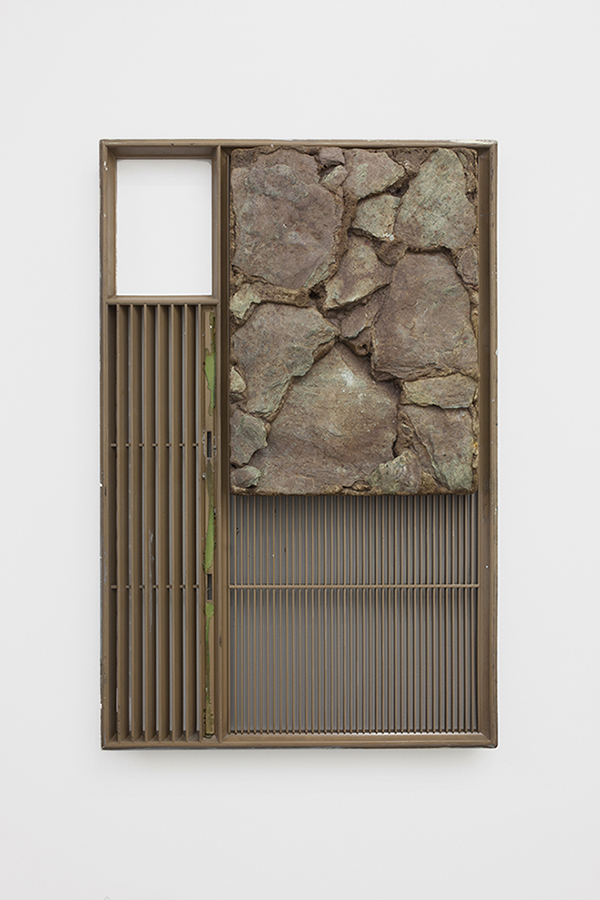
Pass, 2012 . vent cover with rocks . 23.5 x 15.5 x 2 inches ( Photo: Cathy Carver )
You were talking about Smithson and Holt—can we go back to your background? Was minimalism for you and your generation the most important American movement?
Generally I’ve learned from Minimalism to appreciate spaces and situations in light for themselves and from Post-Minimalism/Conceptualism to appreciate that materials and places have histories and narratives already before a user interacts with them. …But to go in a somewhat different direction, for me, I would credit the availability of the idea to transform spaces to watching my Dad build houses when I was growing up, and then to the handful of construction jobs I had when I first moved to New York. From these experiences, watching and making entire spaces transform from day to day, it seemed like a doable task to significantly augment architectural spaces if I committed to using cheap and light-weight materials and a “get it done” work ethic.
Another example, I guess going more into a historical narrative you’re asking about, is that right before I made this installation at Laurel’s gallery I visited Philip Johnson’s Glass House in Connecticut and I was very interested in the visual synthesis of inside and outside. It was a significant lesson to be in and around a house that seemed like picture frames with a roof. For me, the transparency of the house seems like a functional element in service of a cinematic framing effect. It put together some suspicions I was having about relationships between cropping or framing of images and the effects of architectural partitions and apertures. Taking this idea into an art context, I can work with faster and cheaper materials like plastic sheets, wood strips, and staples, and not worry about all of the expense, labor and expertise—the responsibility that accompanies constructing something of actual permanent utility.
And so now, right here, in the Calder residency in the French countryside, I imagine it’s different from what you saw before. You’re really surrounded by the nature. Did it influence the project?
I can hear myself think for the first time in a long time here, and I’ve really been able to observe a whole season evolve day by day. There’s nothing else to disturb the peace other than my own self and wifi. It is easy to have a very focused relationship with activities in the house and studio. These structures, the house and the studio, and for that matter the hills, the valley, the weather, etc. suggest a lot of ideas to me and provides a lot of space for rumination.
And did you get the impression to discover new things in your practice?
Generally I am focusing more on editing ideas here than completing exhibitions. I’ve been building parts—fragments of installations and then spending a lot of time looking at them. When I’m building exhibits I don’t have time to change my mind. I have to start and finish in a few days, at most two weeks, and so there are ideas I have in the process of construction that I can’t try out because there is no time. So, I have a lot of saved-up ideas that I’ve been able to finally pursue here with the space and time to at least think them through again if not try them out. Of course, though, these ideas don’t reanimate exactly the same as before they went into the deep freeze. This place has a lot of influence on how I reengage with these ideas.
So it’s really new shapes that you experience here?
Yes, there are some promising experiments very directly related to this place. I’ve been thinking about a kind of synthesis between the found object work and the on-site installations. When I was a kid I had a hobby of picking out the interesting rocks from our gravel driveway and other dirt roads, and I’ve kind of started doing that again here, just spending time outside looking around every day. I’ve been thinking of the small rocks I’ve collected conversely as rather large particles, and I’ve worked with Guillaume Blanc here at the Atelier Calder to fabricate some clasping mechanisms that hold these particles onto large plastic scrims we stretched in the studio. At night I make marble and coin sized particles out of paper maché and combine them each subsequent night as they dry to make larger conglomerations. I’ve also been doing some pieces where I use linear architectural features as a guide for moving my body, and using video as a kind of tether that connects my body movement with a roof-line or wall edge.
And we can see the black tarps that you’ve been using at the gallery as well.
The black plastic, it’s cheap and fast to work with. I like the black plastic’s ability to seem monumental, to seem as though it is massive without being an actual physically unmovable barrier. It stops your vision but it wouldn’t hold back your body.
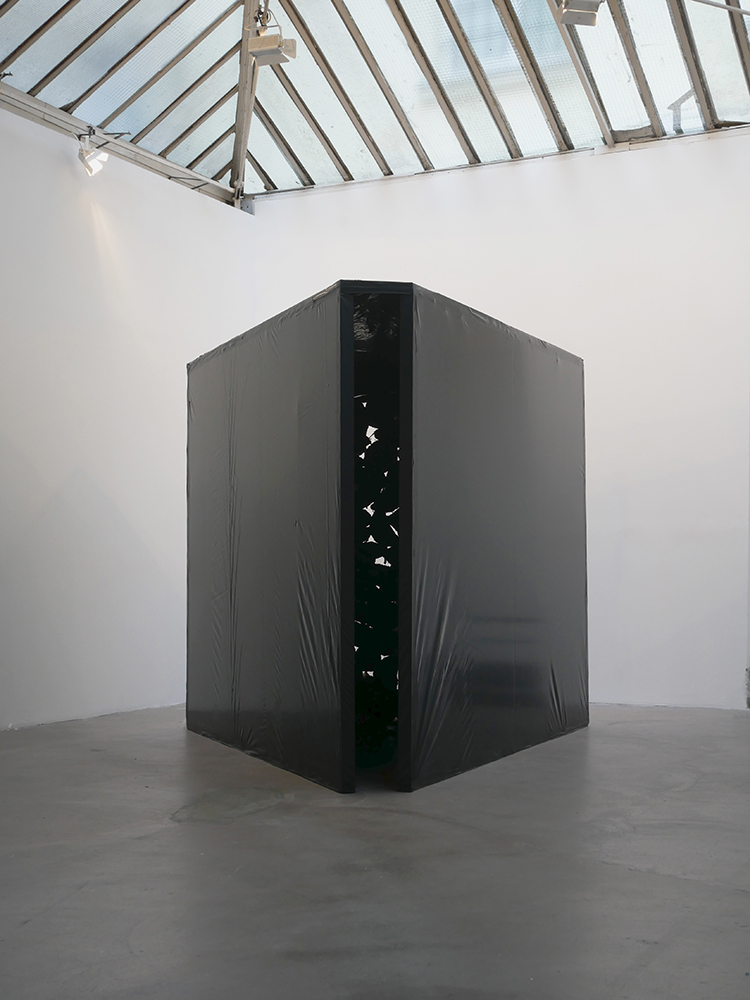
Bill Jenkins presented by Atelier Calder at Foundation Brownstone, Paris, France, 2017 ( Photo: Guillaume Blanc )
I saw that you play a bit with frustration, with the studio where you have a nice view and you block everything.
There’s a large breadth of windows with an amazing view in the studio building, and, yes, I’m blocking it out. There is a show I did with a friend of mine, Alina Tenser, at the Suburban in Chicago a few years ago. It was the first time I blocked out a window and I’ve been thinking about that particular piece, that particular show, quite a lot here, trying to think through that initial piece and what about it I want to continue.
Is it frustration or is it to be more focused?
I like to make exhibitions into sealed bubbles, and that’s about creating focus, yes. I suppose it’s a personal preference as much as a conceptual idea. For example, I can’t write or read near a window, and I’ve covered over windows in different studios before, not as artwork but just so I wouldn’t be constantly distracted by what–anything that’s outside. In terms of exhibitions, I think more in spatial zones rather than isolated objects. I’m working here with semi-enclosures––spatial pockets that are subdivided off of the overall exhibition space.
You said something interesting—when you were in school, the thing that you liked the most was stretching the canvas—can you go back to that?
Yeah, when I arrived at art school as a painter, my favorite thing I learned early on was building stretcher bars. I quickly became very particular about all of the details and decisions about their structure, and I was particular about everything to do with preparing a painting to be made, all the way up to applying paint. At that point, however, my interest sort of diffused. I just didn’t feel connected to imagery or even formal composition. What I didn’t realize at the time, or didn’t have a way of valuing, was that I was more interested in physicality and observation than in my own inventions or decisions standing alone as paint on a surface. I was then and still am much more interested in making a place for images to be, to occur, than making any specific image. The installations I’ve been building (with a lot of help by the way, there is typically a team of two or three or ten people helping me through these tasks) are basically made with a similar structural logic of a fabric (now plastic) pulled taught around a rigid frame, like conventional canvas paintings. Because the installations are functional though—they move light from one place to another—I end up dealing with fewer purely formal dilemmas. Composition of forms becomes very dependent on the structure of an exhibition space rather than an autonomous aspect of the work.
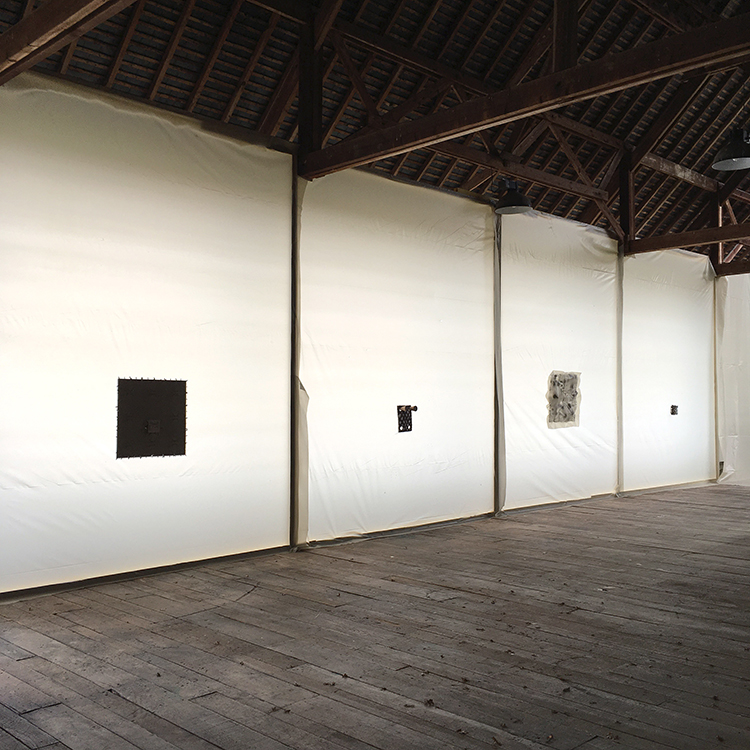
Bill Jenkins open studio at Atelier Calder, Saché, France, 2017